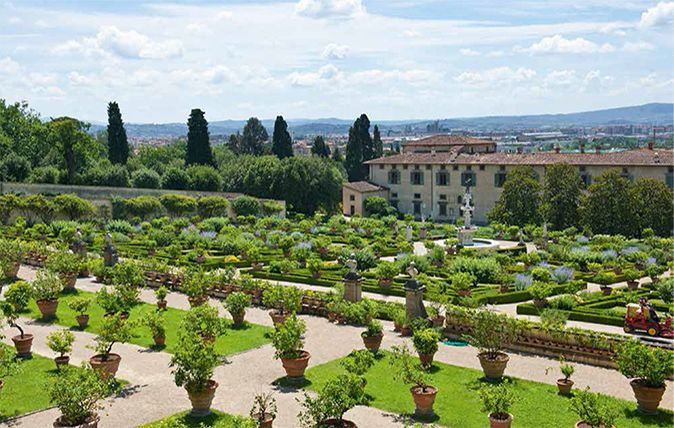Villa Medicea di Castello, Florence
Anyone lucky enough to visit Castello today will find hundreds of heavy terracotta pots of citrus lining paths, flanking steps and marking the corners of flowerfilled parterres


By Helena Atlee
In spring, the garden of Villa Medicea di Castello, in Florence, is saturated in the scent of citrus blossom. Heavy, penetrating and unmistakable, this perfume has been Castello’s hallmark since 1539, when Cosimo I de’ Medici commissioned Tribolo, his favourite architect, to create the garden.
Anyone lucky enough to visit Castello today will find hundreds of heavy terracotta pots of citrus lining paths, flanking steps and marking the corners of flowerfilled parterres. Closer inspection will reveal a wonderful display of strange and unlikely fruit. There may be mandarins and oranges growing on the same plant, citrons with skins raised in terrible carbuncles or lemons shaped like hands with an unsettling number of shiny yellow fingers. Some of the oldest trees at Castello were once part of the largest and most diverse citrus collection in Europe, lovingly accumulated by successive generations of the Medici family. Like a tribe of babies that never left the pram, these trees have existed for 300 years in their pots, outliving generations of gardeners and even the Medici themselves.
When Gian Gastone de’ Medici died in 1737, he left no heirs and all his possessions passed to Francis I of Lorraine. Regime change had little impact on the quiet, well-ordered lives of the citrus trees. They continued to submit to a little light pruning each year and tolerated the move into the shelter of the limonaia— or lemon house—in autumn and out into the garden again in spring.
Each tree was labelled with a number corresponding to an inventory that had been meticulously maintained for hundreds of years. A tree’s number also corresponded to the plinth it stood on in the garden and to its position in the limonaia. The trees became accustomed to the temperature and fall of light in these places and, by replacing them in the same spot each year, the gardeners had learned to minimize the trauma of the transition from inside to out. Nothing interrupted this gentle routine until the limonaia was converted into a hospital during the First World War. Then, the ancient, cosseted trees were abandoned outside to become casualties of a different kind.
Cold made them all die back, but, in some cases, their rootstock survived underground and sent up new shoots. It’s easy to spot these survivors today because their branches are blackened and split and their twisted trunks emerge from gnarled knots of rootstock. Paolo Galeotti, curator at Castello for more than 30 years, admits that visitors sometimes complain about the ugliness of the oldest trees, but he always defends them by saying: ‘We don’t get rid of our old relations just because their legs don’t work and they can’t run.’
With Paolo in charge, life for the trees is much the same as it was under the Medici. They still grow in pots handmade from clay found at Impruneta. These highly porous containers create ideal conditions for citrus. He only has to rap his knuckles against a pot to know if a tree needs watering. A dry pot makes a long, echoing sound, like a bell.
Sign up for the Country Life Newsletter
Exquisite houses, the beauty of Nature, and how to get the most from your life, straight to your inbox.
Paolo has spent decades uncovering contemporary accounts of the collection at its prime and worked hard to restore its wonderful diversity. Originally, the most famous specimen was a chimera, the peculiar fruit occasionally produced when two different citrus species or varieties are grafted together and produce fruit on a branch immediately above the graft that has a jumble of unresolved features. In this case, the chimera, always referred to as the bizzarria or ‘bizarre’, sported green-andorange yellow flesh beneath the skin was that of a lemon.
There was no sign of the bizzarria when Paolo took over, but, some years ago, he noticed a bitter-orange tree with a single twig bearing quite different leaves. Bravely, he cut it off and grafted it on to sour-orange rootstock ‘and, three years later,’ he told me, ‘the grafted twig bore fruit and I realised immediately that I had rediscovered the famous bizzarria.’
Visit Castello today and you may be lucky enough to see the bizzarria. Just like the original, it has striped green-and-orange skin and yellow flesh. And, thanks to Paolo, it will never disappear again.
** Visit Villa Medicea di Castello with our exclusive gardens tour in September
Bringing the quintessential English rural idle to life via interiors, food and drink, property and more Country Life’s travel content offers a window into the stunning scenery, imposing stately homes and quaint villages which make the UK’s countryside some of the most visited in the world.
-
 A quaint village hall in County Durham has been turned in to a truly extraordinary contemporary home
A quaint village hall in County Durham has been turned in to a truly extraordinary contemporary homeThe Village Hall in Shotley Bridge is a masterful conversion of a much-loved village amenity.
By James Fisher Published
-
 Dawn Chorus: The perfect job for incurable romantics, Britain's rudest roads, woodland workshops and spring in Cornwall
Dawn Chorus: The perfect job for incurable romantics, Britain's rudest roads, woodland workshops and spring in CornwallLiving on a near-deserted island, and getting paid for the privilege? No wonder tens of thousands of people were keen.
By Toby Keel Published